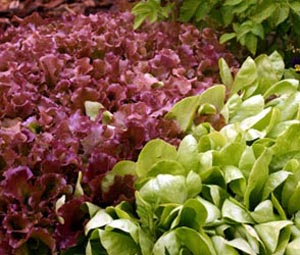
Lettuce is a great garden vegetable, but it doesn’t have to be relegated to rows in the vegetable plot. This versatile plant can add color and texture in ornamental plantings. It looks handsome mixed with annuals in a flower bed, combines well with spring-flowering bulbs, or is a great foliar foil in mixed containers.
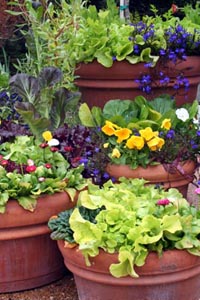
There are innumerable varieties of lettuce in a huge range of colors, leaf shapes and sizes for almost any look. Not all lettuce is the pale green of typical grocery store iceberg lettuce. These days you can find all shades of green from pale to very dark. There are also burgundy or red leaved types, and numerous types mottled or variegated in shades of green and red. Leaf shape varies a lot, too, with choices of smooth edged or deeply indented, such as oak leaf types, and flat or frilly.
There are four main types of lettuce:
Looseleaf types tend to be most attractive as ornamentals but the stiff upright leaves of romaine types or the loose heads of butterhead can offer good contrast to certain plants. Choose from apple green varieties, burgundy tinged or red-leaved cultivars to add a splash of different colors in the ornamental bed.
A few years ago the Royal Horticultural Society evaluated lettuce varieties in England for their ornamental value, as well as freedom from pest and disease. Twenty-six varieties were given Awards of Garden Merit, but few are commercially available in North America. See the complete report.
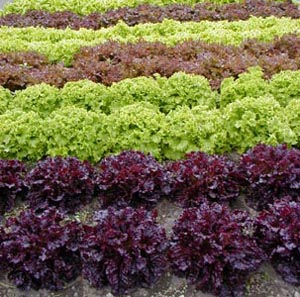
There are hundreds of lettuce varieties available. Some of the more ornamental ones you may wish to try include:
- ‘Amish Deer Tongue’ – a rugged heirloom variety from the 1840’s. The name comes from the shape of the leaves: pointed and triangular with straight edges. The solid green leaves have a thin midrib and a sharp flavor. Has good heat tolerance.
- ‘Bergamo’ – the pale green version of ‘Lolla Rossa,’ it forms a large head with glossy, finely serrated and curled leaves. Heat resistant and very slow to bolt.
- ‘Forellenschuss’ – this Austrian heirloom is a speckled romaine with medium green leaves and delicately splotched with wine-red or maroon.
- ‘Little Gem’ – a green English heirloom romaine that grows only 5-6″ tall. Also known as ‘Sucrine.’
- ‘Lolla Bionda’ – a frilly-edged Italian looseleaf. The deeply curled, jade-green leaves form a compact mound.
- ‘Lolla Rossa’ – a wonderful deeply ruffled and curled looseleaf with pale, frosty green interior and deep magenta edges. It forms frilly half-globe heads and is slow to bolt.
- ‘Merlot’ – a ruby-colored Batavian with waxy, upright savoyed leaves with wavy edges.
- ‘Merveille des Quatre Saisons’ (‘Marvel of Four Seasons’) – a French butterhead heirloom with green leaves tinged with red. It becomes darker red color in cool weather.
- ‘Red Salad Bowl’ – a large, decorative oakleaf looseleaf with wide, maroon-red, deeply lobed leaves. The red color deepens with maturity. ‘Salad Bowl,’ an All America Winner, is its green relative.
- ‘Red Velvet’ – a very dark looseleaf with leaf tops solid maroon and the underside green tinged with red. Slow to bolt.
- ‘Rossa di Trento’ – an Italian looseleaf with oval, wine red-tipped leaves with wavy frilled margins.
- ‘Rouge d’Hiver’ (‘Red Winter’) – a French heirloom romaine with robust heads of reddish-bronze, green-veined leaves.
- ‘Royal Oakleaf’ – a looseleaf with dark green leaves shaped like oak leaves. An improvement over the old ‘Oakleaf.’
- ‘Tango’ – a very dark green looseleaf with tight erect rosettes. The deeply cut, extremely curly, pointed leaves look a lot like endive.
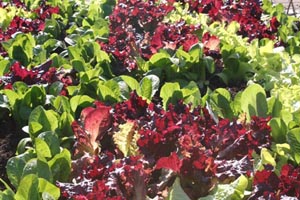
Lettuces with frilly, ornately shaped or beautifully colored leaves can be grown strictly as ornamentals, with no intension of harvesting them to eat, in flower gardens. Use them on the border as an edging or place them in among other plants. When mixing lettuce in with other ornamental plants, use the same principles of design as you would with other foliage plants – select plants to contrast in color and texture with the adjacent plants regardless whether they are other lettuce varieties or herbaceous ornamentals.
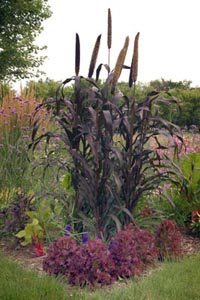
Even when the lettuce begins to go to flower, forming leafy “towers”, the plants still look interesting (though they likely will be bitterly inedible by then). Cutting off the flower spikes as they begin to show will temporarily stop elongation but the plants will do everything they can to flower despite your best efforts. You can continue to cut the inflorescences back or, if it’s late enough in the season, you could replace the flowering lettuce with new, small plants to last through the fall.
Interplanting lettuce you intend to eat with annuals or perennials in flower beds, or among other vegetables in the vegetable garden, can utilize limited space in the small garden. Looseleaf types are the easiest to use decoratively, since you can snip a few leaves here and there without the huge gap that harvesting the whole head of a romaine or crisphead will leave. Alternatively, lettuce plants can be placed so they can be harvested as nearby plants begin to grow and spread and the other plants will then fill in the gaps left after harvest. Start lettuce seedlings indoors, harden them off, and then tuck them into open spots between other plants. This procedure can also be done in early fall in the vegetable garden as other crops are harvested – or even in the perennial garden among early spring bloomers that begin to die back in summer.

Just because a vegetable garden is utilitarian doesn’t mean it has to look like it with everything planted in soldier-straight rows. Pleasing designs and interesting plant combinations can be used to make the overall appearance of the vegetable garden more ornamental (at least until the plants are harvested!). You might try making a lettuce “quilt” of several different varieties. Interplant frilly red lettuce and onions, with their spiky green leaves, in specific or irregular patterns (be sure to cut the lettuce off at the ground when harvesting rather than pulling the plants which could damage the onions’ roots). Use a row of lettuce as an edging around flowers in the cutting garden.

Lettuce is also a wonderful addition to seasonal containers. The attractive foliage complements many types of flowers, including bulbs, in spring. The bold structure adds impact when combined with pansies in spring or fall, and red-leaved varieties can be a strong contrast to the mainly green leaves of cool-season flowers.

And the lettuce will be ready to harvest, if you choose, as warmer weather comes on and plants in the containers are ready to be replaced with summer plantings.
Lettuce is a cool-weather crop that does best in spring and fall, but there are cultivars that are more heat tolerant – often labeled as “summer lettuce.” Most cultivars do best in full sun but many do well in light shade during the summer.
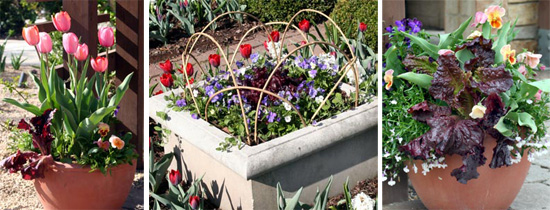
It’s fun and easy to create quite an interesting display with exclusively or mainly edible plants, featuring lettuce and other vegetable plants that can be quite ornamental, such as Swiss chard, kale, cabbage, basil, and some varieties of peppers.
– Susan Mahr, University of Wisconsin – Madison




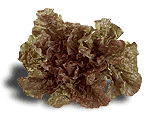




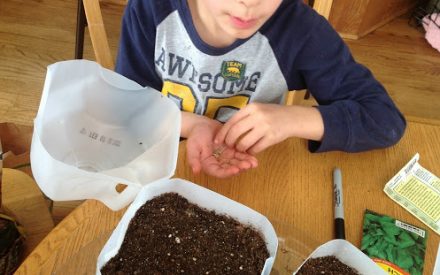 Seed Starting
Seed Starting Growing Vegetables at Home: Questions and Answers
Growing Vegetables at Home: Questions and Answers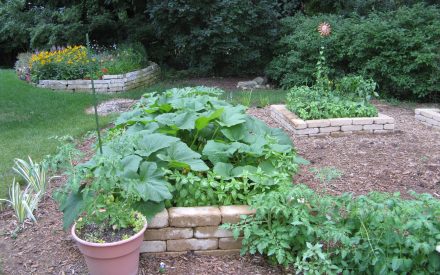 Growing Vegetables in Containers
Growing Vegetables in Containers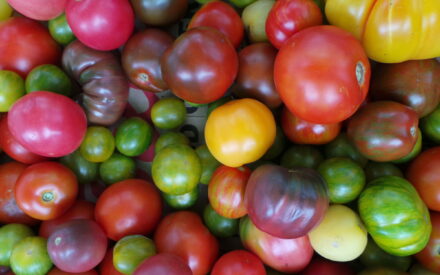 Home-Grown Tomatoes for Wisconsin
Home-Grown Tomatoes for Wisconsin


